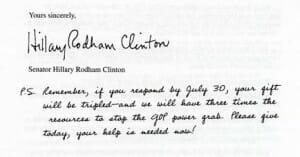When it comes to fundraising appeals, too many of us in the nonprofit world are stuck on ourselves.
How can that be, we wonder? We’re not self-centered. We care about our mission. We care about our clients. We’re not in it for personal gain–or we surely would have chosen another profession! How can it be that we’re constantly writing about ourselves?
Yet take a look at the last appeal letter your agency sent out. Did it contain:
- Statistics on how many people “we” helped?
- Explanations of “our” programs?
- Stories about what “we” did that changed client’s lives?
We, the nonprofit vs. they, the donors
What we’re trying to do with those letters is make a case for the donor’s support. What we’re succeeding at doing–far too often–is making them feel insignificant.
Saying “We need your help” is not convincing when the rest of the letter is about what “we” did without the donor even knowing. Worse, it puts us on opposite sides of the fence: “we” who do, and “you” who admire.
Yes, that organization sounds great, the donor thinks. So what? What’s that got to do with me?
That’s the question your ideal appeal letter must answer.
All of us, together
Think back to the end of 2015. At home, in the mail, you got a ton of letters asking for money. Was there one that made you excited about giving?
If so, I’ll bet it got the little things right. It called you by your name. It referred to your giving history. It packed some punch in the postscript.
But that’s only what it took to get you to read the letter. What made you remember it, and feel excited about it, and want to give?
The letter that makes you feel like you were there in the midst of the action all along.
The letter that says the success stories are your successes.
The appeal letter that makes the donor the hero of the story.
That’s the one that stays in the memory. That’s the letter that donors want to keep, and quote, and show to their friends.
And that’s the letter that your nonprofit organization wants to write.
Every Tuesday this season, I’m offering a tip on how to write better fundraising appeals. Find the rest of the series under Fundraising Tuesday.



